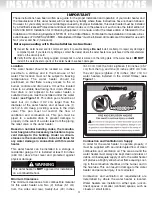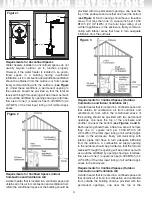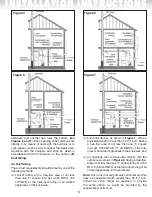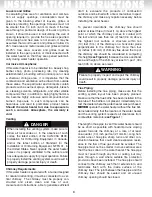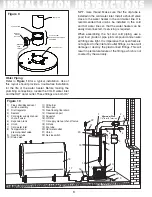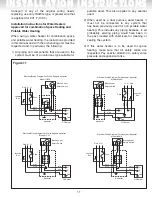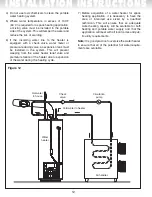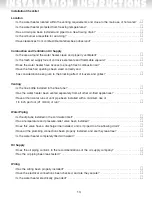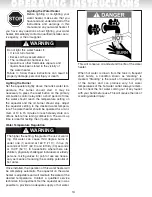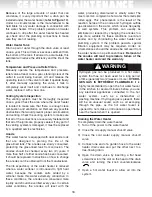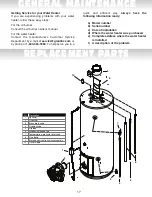
15
GENERAL MAINTENANCE
Housekeeping
DO NOT
store or use gasoline or any other flam-
mable vapours or liquids around the water heater.
DO NOT
put or store any objects on the top of the
water heater. Failure to follow these instructions
can result in property damage, personal injury or
death.
Annual Service by a Contractor
The combustion chamber is fragile. Use care when
inspecting and cleaning this area. The heat exchang-
er flue passage and baffle should be inspected peri-
odically and cleaned if necessary. A wire brush can
be used to loosen dirt and debris on the inside sur-
face of the flue passage and baffle. Clean out all
accumulated dirt and soot with an industrial vacuum
cleaner, paying close attention to the combustion
chamber area.
Routine Maintenance by the Home Owner
Keep the area around the water heater clean and
free of dust, lint and dirt. Make sure that all of the
minimum clearances to combustible materials are
being maintained. On a regular basis, you should
inspect the general conditions of the water heater,
watching for signs of oil leaks in the vicinity of the oil
burner and soot forming on any external part of the
water heater or joints of the vent pipes, etc. If any of
these conditions are present, please advise your
service or installation contractor. The water heater
should be serviced on an annual basis by a qualified
service technician.
Oil Burner Air adjustment
At the time of installation, and at least at each annual
cleaning or inspection, a test for smoke density and
carbon monoxyde (CO) must be performed. Drill a
test port in the venting between the water heater flue
outlet and the draft regulator (barometric damper). It
is essential for the proper operation of the water
heater that this adjustment is performed with the use
of combustion instruments, as a visual inspection is
not sufficient. Oil-fired water heaters tend to run with
shorter operating cycles and it is therefore important
for the burner to be adjusted to provide a good flame.
A lack of air causes “sooty” or “soft” flames, resulting
in soot build-up throughout the heat exchanger pas-
sages. Excess combustion air causes a bright roar-
ing fire and high stack temperatures resulting in poor
fuel efficiency.
After the burner has been firing for 10-15 minutes,
take a smoke sample with a Bacharach smoke
sampler or other approved device. Then, take a sam-
ple of the flue gases and test for CO using a combus-
tion analyser. The smoke spot should not exceed
“Trace” on the Bacharach Scale. The water heater
operates most efficiently with a “Trace” smoke spot.
For complete details on adjusting the air, please con-
sult the oil burner instruction manual
provided with the burner.
Burner electrode
Correct positioning of the electrode tips with respect
to each other, to the fuel oil nozzle and to the rest of
the burners is essential for smooth light ups and
proper operation. Refer to the oil burner instructions
shipped with the burner for electrode specifications.
Burner primary (safety) control
The oil burner is equipped with a primary combus-
tion control, sometimes referred to as the burner
relay or burner protector relay, which uses a light
sensing device (cad cell) located in the burner
housing, to monitor and control combustion. Over
time, dust or combustion residuals can build up on
the lens of the cad cell impairing its response to
the flame. The cad cell should be checked for
cleanliness and proper alignment if the primary
control frequently shuts down combustion.
Shutting Down the Water Heater
Always keep the oil supply manual shut-off valve-
closed if the burner is shut down for an extended
period of time
Set the aquastat to the lowest possible setting.
Turn off all of the electrical power to the water heater.
Condensation
As moisture from the products of combustion comes
into contact with the cold surface of the inner tank, it
may condense. This situation will usually occur:
1) When the water heater is filled with cold water for
the first time.
2) If the water heater has been undersized.
3) When large amounts of hot water are drawn from
the water heater in a short period of time and the
refill water is very cold.
Due to the high-efficiency rating of this oil-fired water
heater, it may produce more condensation than older
models. This condition is not uncommon and must
never be misinterpreted as a leaking tank. It will
disappear once the water becomes heated.
WARNING
WARNING



